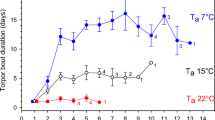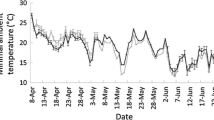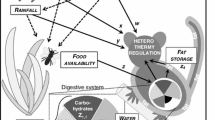Abstract
We studied how food abundance and consumption regulates torpor use and internal organ size in the Chilean mouse-opossum Thylamys elegans (Dielphidae), a small nocturnal marsupial, endemic in southern South America. We predicted that exposure to food rations at or above the minimum energy levels necessary for maintenance would not lead to any signs of torpor, while reducing food supply to energy levels below maintenance would lead to marked increases in frequency, duration and depth of torpor bouts. We also analyzed the relationship between food availability and internal organ mass. We predicted a positive relationship between food availability and internal organ size once the effect of body size is removed. Animals were randomly assigned to one of two groups and fed either 70, 100 or 130% of their daily energy requirement (DER). We found a positive and significant correlation between %DER and body temperature, and also between %DER and minimum body temperature. In contrast, for torpor frequency, duration and depth, we found a significant negative correlation with %DER. Finally, we found a significant positive correlation between the %DER and small intestine and ceacum dry mass. We demonstrate that when food availability is limited, T. elegans has the capacity to reduce their maintenance cost by two different mechanisms, that is, increasing the use of torpor and reducing organ mass.





Similar content being viewed by others
Abbreviations
- DER:
-
Daily energy requirement
- T b :
-
Mean body temperature
- T bmin :
-
Minimum daily body temperature
- Torporfreq :
-
Mean number of torpor bout per day
- T btorpor :
-
Mean temperature during torpor events
- T s :
-
Skin surface temperature
References
Bacigalupe LD, Bozinovic F (2002) Design, limitations and sustained metabolic rate: lessons from small mammals. J Exp Biol 205:2963–2970
Brown KJ, Downs CT (2006) Seasonal patterns in body temperature of free-living hyrax (Procavia capensis). Comp Biochem Physiol 143A:42–49
Bozinovic F, Méndez MA (1997) Role of dietary fatty acids on energetics and torpor in the chilean mouse-opossum Thylamys elegans. Comp Biochem Physiol 116A:101–104
Bozinovic F, Ruiz G, Rosenmann M (2004) Energetics and torpor of a South American living fossil, the microbiotheriid Dromiciops gliroides. J Comp Physiol B 174:293–297
Bozinovic F, Ruiz G, Rosenmann M (2005) Energetics, thermoregulation and torpor in the chilean mouse-opossum Thylamys elegans (Didelphidae). Rev Chil Hist Nat 78:199–206
Carey HV (1990) Seasonal changes in mucosal structure and function in ground squirrel intestine. Am J Physiol 259:R385–R392
Carey HV, Sills NS (1996) Hibernation enhances D-glucose uptake by intestinal brush border membrane vesicles in ground squirrels. J Comp Physiol B 166:254–261
Chappell MA, Dawson TJ (1994) Ventilatory accomodation of changing oxygen consumption in dasyurid marsupials. Physiol Zool 67:418–437
Cant JP, McBride BW, Crom WJ Jr (1996) The regulation of intestinal metabolism and its impact on whole animal energetics. J Anim Sci 74:2541–2553
Carey HV, Sills NS (1992) Maintenance of intestinal nutrient transport during hibernation. Am J Physiol 263:R517–R523
Carey HV (2005) Gastrointestinal responses to fasting in mammals—lessons from hibernators. In: Starck JM, Wang T (eds) Physiological and ecological adaptations to feeding in vertebrales. Science Publishers, New Hampshire, USA
Cryan PM, Wolf BO (2003) Sex differences in the thermoregulation and evaporative water loss of a heterothermic bat, Lasiurus cinereus, during its spring migration. J Exp Biol 206:3381–3390
Debnam ES, Levin RJ (1975) Effects of fasting and semi-starvation on the kinetics of active and passive sugar absorption across the small intestine in vivo. J Physiol (London) 252:681–700
Ferraris RP, Carey HV (2000) Intestinal transport during fasting and malnutrition. Annu Rev Nutr 20:195–219
Galluser M, Raul F, Canguilhem B (1988) Adaptation of intestinal enzymes to seasonal and dietary changes in a hibernator: the european hamster (Cricetus cricetus). J Comp Physiol 158:143–149
Geiser F (1986) Hibernation and daily torpor in two pygmy possums (Cercartetus spp., Marsupialia). Physiol Zool 60:93–102
Geiser F (1988a) Reduction of metabolism during hibernation and daily torpor in mammals and birds: temperature effect or physiological inhibition? J Comp Physiol 58:25–37
Geiser F (1988b) Daily torpor and thermoregulation in Antechinus (Marsupialia):influence of body mass, season, development, reproduction, and sex. Oecologia 77:395–399
Geiser F (1994) Hibernation and daily torpor in marsupials: a review. Aust J Zool 42:1–16
Geiser F (2004) Metabolic rate and body temperature regulation during hibernation and daily torpor. Annu Rev Physiol 66:239–274
Gibson LA, Hume ID (2000) Seasonal field energetics and water influx rates of the greater bilby (Acrotis lagotis). Aust J Zool 48:225–239
Goodman MN, Fleck A (1980) Starvation in the rat I. Effect of age and obesity on organ weights, RNA, DNA and protein. Am J Physiol 239:E269–E276
Guppy M, Withers P (1999) Metabolic depression in animals: physiological perspectives and biochemical generalizations. Biol Rev 74:1–40
Hallam JF, Dawson TJ (1993) The pattern of respiration with increasing metabolism in a small dasyurid marsupial. Respir Physiol 93:305–314
Holloway JC, Geiser F (1995) Influence of torpor on daily expenditure of the dasyurid marsupial Sminthopsis crassicaudata. Comp Biochem Physiol 112A:59–66
Holloway JC, Geiser F (2001) Effects of helium/oxygen and temperature on aerobic metabolism in the marsupial sugar glider, Petaurus breviceps. Physiol Biochem Zool 74:219–225
Hume ID, Beiglbock C, Ruf T, Frey-Roos F, Bruns U, Arnold W (2002) Seasonal changes in morphology and function of the gastrointestinal tract of free-living alpine marmots (Marmota marmota). J Comp Physiol B 172:197–207
Humphries MM, Thomas DW, Kramer DL (2001) Torpor and digestion in food storing hibernators. Physiol Biochem Zool 74:283–292
Karasov WH, Diamond JM (1983) Adaptive regulation of sugar and amino acid transport by vertebrate intestine. Am J Physiol 8:G443–G462
López-Calleja MV, Bozinovic F, Martínez del Río C (1997) Effect of sugar concentration on hummingbird feeding and energy use. Comp Biochem Physiol 118A:1291–1299
Lovegrove BG (2005) Seasonal thermoregulatory responses in mammals. J Comp Physiol B 175:231–247
Lovegrove BG, Lawes MJ, Roxburgh L (1999) Confirmation of pleisiomorphic daily torpor in mammals: the round-eared elephant shrew Macroscelides proboscideus (Macroscelidea). J Comp Physiol B 169:453–460
Lovegrove BG, Raman J, Perrin MR (2001) Heterothermy in elephant shrews, Elephantulus spp.(Macroscelidea): daily torpor or hibernation? J Comp Physiol B 171:1–10
McBride BW, Kelly JM (1990) Energy cost of absorption and metabolism in the ruminant gastrointestinal tract and liver: a review. J Anim Sci 68:2997–3010
McNab BK (1983) Energetics, body size and the limits of endothermy. J Zool Lond 199:1–29
McNab BK (2002) The physiological ecology of vertebrates. A view from energetics. Cornell University, Cornell
Mzilikazi N, Lovegrove BG (2004) Daily torpor in free-ranging rock elephant shrews, Elephantulus myurus: a year-long study. Physiol Biochem Zool 77:285–296
Nagy KA (2001) Food requirements of wild animals: predictive equation for free-living mammals, reptiles, and birds. Nutr Abstr Rev B 71:21R–31R
Naya DE, Bacigalupe LD, Bustamante DM, Bozinovic F (2005) Dynamic digestive strategies in response to increased energy demands: a study in the leaf-eared mouse. J Comp Physiol B 175:31–36
Naya DE, Bozinovic F (2006) The role of ecological interactions on the physiological flexibility of lizards. Funct Ecol 20:601–608
Piersma T, Lindstrom A (1997) Rapid reversible changes in organ size as a component of adaptative behaviour. TREE 12:134–138
Sabat P, Bozinovic F (1994) Cambios estacionales en la actividad de enzimas digestivas en el pequeño marsupial Thylamys elegans: disacaridasas intestinales. Rev Chil Hist Nat 67: 221–228
Sabat P, Bozinovic F, Zambrano F (1995) Role of dietary substrates on intestinal disaccharidases, digestibility and energetics in the insectivorous mouse-opossum (Thylamys elegans). J Mamm 76:603–611
Secor SM, Stein ED, Diamond JM (1994) Rapid upregulation of snake intestine in response to feeding: a new model of intestinal adaptation. Am J Physiol 266:G696–G705
Silva-Durán IP, Bozinovic F (1999) Food availability regulates energy expenditure and torpor in the chilean mouse-opossum Thylamys elegans. Rev Chil Hist Nat 72:371–376
Starck JM (1999) Structural flexibility of the gastro-intestinal tract of vertebrates—implications for evolutionary morphology. Zool Anz 238:87–101
Statistica (2001) STATISTICA (quick reference) for the Windows operating system. StatSoft, Tulsa, OK
Wang Z, O’Connor TP, Heshka S, Heymsfield SB (2001) The reconstruction of kleiber’s law at the organ-tissue level. J Nutr 131:2967–2970
Wiener J (1992) Physiological limits to sustainable energy budgets in birds and mammals: ecological implications. TREE 7:384–388
Acknowledgments
Funded by FONDAP 1501-0001 (program 1) to FB and FONDECYT 3060046 to DEN. Two anonymous reviewers made valuable comments.
Author information
Authors and Affiliations
Corresponding author
Additional information
Communicated by I.D. Hume.
Rights and permissions
About this article
Cite this article
Bozinovic, F., Muñoz, J.L.P., Naya, D.E. et al. Adjusting energy expenditures to energy supply: food availability regulates torpor use and organ size in the Chilean mouse-opossum Thylamys elegans . J Comp Physiol B 177, 393–400 (2007). https://doi.org/10.1007/s00360-006-0137-0
Received:
Revised:
Accepted:
Published:
Issue Date:
DOI: https://doi.org/10.1007/s00360-006-0137-0




